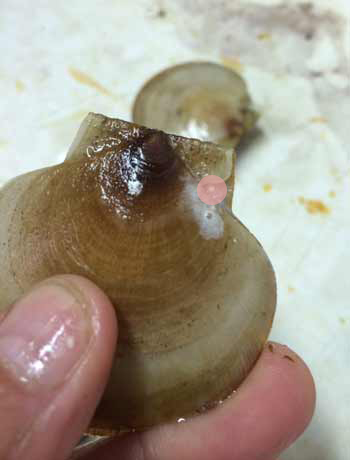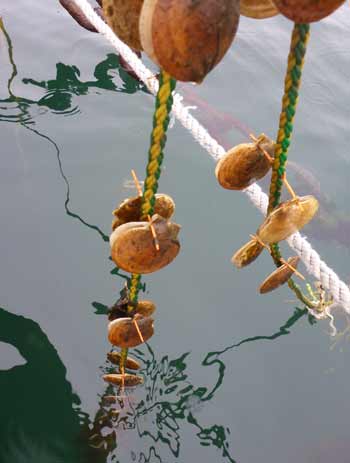Japan Visit Offers New View of Scallop Aquaculture
by Dana Morse, Maine Sea Grant Extension

On the bottom shell of the scallop is the ‘byssal notch,’ and this is the proper position to drill a hole in the upper shell.
Scallop farming in Japan is big business and a prime reason why the working waterfront there is so busy. Aquaculturists from Maine are trying to learn from that success and traveled recently to Aomori Prefecture for a deep dive into the machinery, environmental factors, scientific and management support, and husbandry techniques that have made the industry so strong.
The trip follows several delegations that have traveled back and forth between Maine and Aomori, and had its roots in the Maine-Aomori sister-state relationship, which in turn grew from the wreck of the Bath-built Chesborough off the coast of Shariki in 1889. This most recent delegation was led by Don Hudson, Maine chair of the Maine-Aomori Sister-State Advisory Council, and Hugh Cowperthwaite, director of the Fisheries Project at Coastal Enterprises, Inc.
Aomori Prefecture surrounds Mutsu Bay, a nearly-enclosed body of water that opens northward to the Tsugaru Strait, between the islands of Honshu and Hokkaido. About 600 vessels are involved in the scallop industry on Mutsu Bay alone; approximately 2,000 individuals have on-the-water employment there.
In many cases, these are family operations and the boat crew will commonly consist of a husband and wife and one or more of their children.
Mutsu Bay produces roughly 90,000 metric tons of scallops annually (the Japanese scallop is Patinopecten yessoensis, also referred to as the Ezo scallop), compared to approximately 400,000 metric tons produced in Hokkaido.
These weights are reckoned for whole, in-shell product. The Aomori industry is principally made up of suspended culture — lantern nets, pearl nets and earhanging — and the bottom-seeding method is more common in Hokkaido. The suspension-culture sector is fully mechanized, and that mechanization was a principal reason for our visit.
The manufacturer and inventor of many of these machines is Hiroaki Sugiyama, owner of Mutsu Kaden Tokki Co., Ltd. Mr. Sugiyama and his sons have been creating and improving specialized machinery for the scallop industry for over 40 years now. A group of Mainers visiting Aomori in 2010 were introduced to him and his work and his visit to Maine in 2014 confirmed the possibilities that ear-hanging technology has promise here.
The method itself is simple but labor-intensive, hence the mechanization. Wild seed scallops are gathered using spat collectors, identical to those that have been in use in Maine for nearly two decades now. Collectors consist of bags roughly the size of a pillowcase and made of plastic mesh. The bag mesh size is about 3.0mm and the inside of the bag is filled with a different type of plastic mesh, called Netron. Larval scallops are carried into the bag by the currents, and settle on the Netron filling, where they go through a metamorphosis, becoming scallop seed. Once the scallop seed grow for a while, they become too big to escape through the outer bag. A single collector can easily retain 1,000-3,000 scallops or more in Maine, but in Aomori there are recorded incidences of a single collector retaining over one million scallop larvae — a benefit of both the local oceanography and the nearby presence of so many spawning scallops on the farms. Settlement season is different in Aomori and Maine; Japanese collectors go out from April to May, whereas collectors are commonly deployed in coastal Maine waters from mid-September through mid-October.
In Japan when the scallops are removed from the collectors, they are usually about 1-2 cm in size and must grow some more in what’s usually referred to as a nursery system. Japanese nursery culture consists mostly of pearl nets, pyramidal nets that hang in strings from a horizontal longline. Since P. yessoensis grows quickly, the time in the nursery is fairly short, usually about five months or so. The nursery phase is a lot shorter than for our native sea scallop (Placopecten magellanicus), which is not an impossible situation to overcome, for those who may be thinking about scallop aquaculture in Maine. The goal is to achieve a 50-70mm shell length at which point the scallops can be put onto ear-hanging lines or set onto the bottom for final grow-out.
Our group was interested in learning more about the ear-hanging technique. Ear-hanging works on the premise that by maximizing the scallops’ ability to feed and by keeping them away from predators, growth is maximized and mortality is minimized. It appears to work for Mutsu Bay fishermen, because there are a lot of successful Japanese businesses in the area and plenty of new vessels and new gear to be seen. (Note: In keeping with Japanese tradition most of the people met on the trip were referred to by others as fishermen, and they referred to themselves that way also.)
The ear-hanging (mimi-zuri, in Japanese) arrangement is simple but uses an odd mix of machinery and manual work to accomplish the various tasks. The main element of the production system is the longline (also referred to as a “backline”), a rope held horizontally in the water at a certain depth and maintained there by anchors and surface buoys. Backline is commonly 28mm nylon line, used because of its strength and stretch — these lines take a lot of tension.

A line of scallops; drilled, pinned through drilled holes in the shells and ropes, and hung for grow-out on the Damariscotta River, Maine. Scallops grow on these lines for 12 to 24 months. They are cleaned by machine annually.
From this longline are hung dropper lines and strings of nursery gear such as the pearl nets (lantern nets are used too, more for growing larger scallops) or dropper lines that are used for grow-out to larger sizes. The dropper lines are either braided rope with plastic pins at intervals (called “age-pins,” pronounced ah-gay), or lines with monofilament loops (called “loop cord” lines); both are in common use.
To get the scallops onto either age-pins or loop cords, a hole is drilled through the upper shell, near the hinge of the scallop. The target area for drilling is the byssal notch of the lower shell. By drilling through only one shell, tissue damage is minimized, and growth is not badly affected. There are a variety of machines that can do this step, but they all involve a high-speed drill and a hardened drill bit of about 1.5mm diameter. Once the hole is drilled through the shell, the scallops are either attached by hand or in some cases the drilling machine will also attach the scallops to the pin. Both methods are widely used.
Loop cords are used because growth appears to be faster with them than on age-pins and labor for stringing the scallops is thought to be less costly. The loop cord allows a line of monofilament to be passed through the drill holes of the scallop and keeps it tight enough so that the scallops don’t tangle — like fishing line going through the ferrules of a fishing rod. Scallops are usually strung two per gap between the loops, or about six per running foot, compared to four per running foot for age-pins.
Once the scallops are attached to the lines, the dropper lines are tied onto the backline. It’s common to have 80-100 pins per line, so the droppers can be 40 or 50 feet long. The backline floats at about 15 feet below the surface, so some depth is needed for the whole arrangement; otherwise, the droplines would drag on the seabed and would become easy targets for climbing starfish and crabs.
Scallops grow on these lines for 12 to 24 months, during which time they are cleaned by machine once or twice per year. The cleaning machine uses highpressure water to get rid of fouling organisms and can manage a dropline of 100 pins in about two minutes. It’s expensive but effective, and virtually all the boats in the Japanese industry have such equipment aboard.
Given the early work with the ear-hanging method in Maine, it’s not at all unreasonable to think about growing a 2.- or 2.5-inch scallop to 4 inches within about 12 months from drilling, or a 5-inch shell within 24 months. Meat weights are projected to be 20-count after a year and 15 count after two years, though further data collection will clarify this. Longlines are commonly 200 meters long and will have 400-600 drop lines, each carrying up to 200 scallops. In such an instance, a 200-meter line may easily have upwards of 50,000 scallops aboard, and at 20/pound and a $14/per pound value, that’s $35K of product potentially coming from one line (Caution – this is farming, and nothing is guaranteed!)
The Maine delegation visited with scientists, the equipment specialists at Mutsu Kaden Tokki Co., and with several fishermen in the Hiranai Fisheries Cooperative, which is the largest co-op on Mutsu Bay. In coming weeks and months, more outcomes from this trip will occur, as what we learned is put into practice more fully and as we gather more information on ear-hanging as a potential method for scallop culture in Maine.
This trip to Mr. Sugiyama’s part of the world was made possible both through the United States Japan Foundation and through funding by Maine Technology Institute. Th e MTI Cluster Development Award will also support the purchase of a limited amount of ear-hanging equipment, to jump-start the pilot-scale production of scallops via this method.
